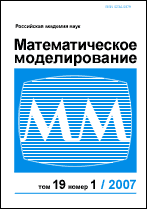|
This article is cited in 4 scientific papers (total in 4 papers)
Mathematical models and computer experiment
Analysis of temperature and thermal stress fields in pulse treatment of semiconductors
V. I. Mazhukina, V. V. Nosova, U. Semmlerb
a Institute for Mathematical Modelling, Russian Academy of Sciences
b Chemnitz University of Technology
Abstract:
High-energy beam treatment of semiconductors presents a modern alternative to conventional
technology. In pulsed processing high temperature gradients leads to high compressive therm alstresses. The thermal diffusivity of the considered semiconductors germanium and silicon decreases considerabely with temperature increase, which leads to additional heat built-up in the thermal affected zone. The considered axisymmetric thermomechanical problem consists of non-linear and nonstationary heat conduction and quasi-stationary thermoelasticity at fixed times. The temperature distribution and the thermal stresses are calculated by a hybrid Finite Difference/Finite Element method. The finite-difference and finite-element approaches use different node distributions, and the interpolation interface between to two methods transforms the values from one grid to another. The performed modeling have shown that at heating up the target to melting temperature, maximum thermal stresses on the surface of germanium exceeds values on the surface of silicon approximately on 40% .
Received: 08.02.1999
Citation:
V. I. Mazhukin, V. V. Nosov, U. Semmler, “Analysis of temperature and thermal stress fields in pulse treatment of semiconductors”, Matem. Mod., 12:2 (2000), 75–83
Linking options:
https://www.mathnet.ru/eng/mm843 https://www.mathnet.ru/eng/mm/v12/i2/p75
|

| Statistics & downloads: |
| Abstract page: | 495 | | Full-text PDF : | 257 | | First page: | 2 |
|




 Contact us:
Contact us: Terms of Use
Terms of Use
 Registration to the website
Registration to the website Logotypes
Logotypes








 Citation in format
Citation in format 
